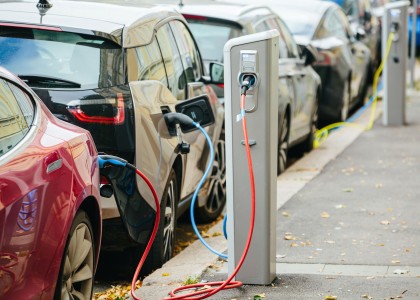This post is the third in a series focused on the energy efficiency implications of the COVID-19 pandemic. The first post explored how to reduce transmission risks in buildings without wasting energy, and the second one looked at how to create safe, sustainable schools.
As the United States enters the most serious phase of the COVID-19 pandemic thus far, and many households continue to restrict their daily activities, personal vehicles are increasingly seen as the safest way to travel, to the detriment of more efficient modes of transportation. Public transit, in particular, has seen a significant reduction in ridership. Transportation data company Transit estimates that the demand for services across all major metropolitan areas in the country is currently 66% lower than normal. To ensure it remains a viable option, especially as the U.S bounces back from the pandemic, transit will need to regain public confidence, and its struggling systems will need guaranteed financial support.
Research has shown very little evidence that public transit systems are the super-spreaders that many people think they are. While commuters are understandably skittish about riding on buses or trains, data from around the world does not show a direct correlation between public transit and COVID transmission. In Paris, none of the early COVID-19 clusters in April or May were traced back to public transportation. Likewise, cities like Tokyo and Hong Kong, which have robust public transit ridership and dense systems, have not seen any clusters originate from their public transportation facilities. In New York City, COVID-19 rates are entirely unrelated to trends in transit ridership.
In any case, transit agencies can use a number of global best practices to lure commuters back to buses and trains, including the following:
- Enforcing face-covering rules
- Creating and implementing daily protocols for cleaning and sanitization
- Limiting capacity on buses and trains and using real-time data to help riders identify less-crowded times to use services
Transit’s value
Such measures will be vital, because public transit serves as the backbone of major urban centers and is the single cleanest and most efficient way to move people en masse. It produces 50% less carbon dioxide per passenger mile than an average private vehicle. But beyond the climate and energy impacts, public transit access creates healthy, livable, economically thriving communities. Transit connects households to critical job centers and, during the pandemic, has been indispensable to medical, frontline, and other essential workers. Equally important are the air pollution benefits that accrue as a result of moving passenger travel away from personal vehicles and reducing congestion, especially as underlying respiratory illnesses make people significantly more susceptible to COVID-19. Residents gain additional health benefits as they walk to and from stations and hubs.
Even before the pandemic, transit agencies saw steep drops in fare-based revenues, as they have struggled in recent years to achieve steady and significant levels of ridership. COVID-19 could hamper the return of reliable public transportation if policies aren’t enacted to support these systems. As the pandemic continues, ensuring that urban residents have access to public transit will be crucial. In particular low-income communities and communities of color are likely to bear a disproportionate impact of unreliable access to public transportation options. African Americans, for example, account for 12% of the U.S. population but 24% of public transportation riders. Access to public transit and other shared mobility options reduce transportation expenses for low-income households and may obviate the need for vehicle ownership.
Federal funding
The best practices discussed above will help only if public transit facilities receive the financial support required to continue providing reliable essential service and maintaining facilities. The federal government’s first round of 2020 stimulus funding, passed in March, included $25 billion in emergency financial aid for transit agencies. In October, the HEROES act allocated an additional $32 billion, but it passed only the House, not the Senate. With the next round of stimulus funding still up in the air and emergency aid quickly running out, transit agencies are looking to more permanent funding at the federal, state, and local levels.
Federally, part of the solution will involve creating sustained pots of funding for non-highway modes of transportation. The Highway Trust Fund (HTF) is the primary source of federal transportation dollars and is largely directed to road-based capital investments. While the HTF can also fund transit infrastructure improvements, typically only about 20% of the funds are allocated to transit. Additionally, the HTF has needed periodic infusions of general government revenues to cover severe shortfalls. The transportation reauthorization bill could help address this imbalance by identifying specific carve-outs from the HTF for public transit and also creating additional sources of funding. The Moving Forward Act proposal released by the House this past summer takes some initial steps to do the above, allocating an additional $105 billion for transit procurement, maintenance, and operation.
Other financing options
Innovative funding solutions have appeared at the state level in recent years. An increasing number of states are considering carbon pricing programs that will allocate collected revenues to sustainable transportation efforts including vehicle electrification, public transit operation, maintenance, and expansion, and bicycle/pedestrian infrastructure. California’s cap-and-trade program is the best example. The state deposits funds into the Greenhouse Gas Reduction Fund and distributed among state agencies to finance projects that have demonstrated GHG reduction impacts. More recently, the Transportation and Climate Initiative’s proposed regional cap-and-invest program offers an opportunity to shore up flagging transportation systems in participating states by placing a cap on transportation emissions and requiring gasoline and diesel wholesalers to purchase allowances for the carbon content of their fuels. Revenues must then be directed to efficient transportation solutions.
As COVID-19 continues to take a bite out of fare revenues, local solutions like congestion pricing can supplement funding generated at the federal and state levels. Like carbon pricing efforts, collected funds could be directed to efficient transportation options. Congestion pricing programs, such as the one New York City is planning, also improve livability and localized air quality in urban areas and communities located near high-traffic corridors. In general, federal, state, and local solutions will need to ensure that funding as well as equitable pollution and transportation access outcomes go to the communities that need them most. COVID-19 impacts have ravaged low-income communities and communities of color, which have historically borne a higher health burden from transportation-related emissions. The current U.S. transportation system has been shown to further compound the inequalities between Black and white populations.
As COVID-19 continues to devastate the U.S. population and economy, investing now in public transit will not only serve as a much-needed economic stimulus once the nation emerges from the pandemic, but will also lead to more efficient, accessible, and equitable transportation systems in the long run.



